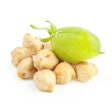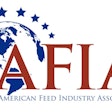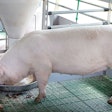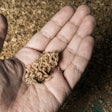Stored grain, as with other durable stored commodities and their value-added products, are at their highest quality just after harvest or manufacturing, and are at risk of decreased quality during storage from the depredations of insects, molds, vertebrate pests and physical damage. A new technical training book produced by Kansas State University titled,Stored Product Protection, details the types of pests and damaging agents, methods for management, prevention of infestation, control and the economics and regulatory issues associated with changes in grain quality and the practice of pest management.
Stored Product Protectionis written for individuals involved with grain storage, commodity storage and management, food processing, and pest management. Its target audience also includes academic, government, and private sector researchers in these fields, and regulatory personnel. Though the book focuses on North America, examples are drawn from stored product experiences in many parts of the world. Comprised of 31 chapters written by experts in the field, the tome is split into three major subjects:
• The biology and ecology of insects, molds, and vertebrates in storage systems;
• Insect pests of cereal grains and legumes, dried fruits and nuts, and processed and durable commodities of both plant and animal origins; and,
• The various aspects of pest management, i.e. prevention methods, monitoring-based methods, decision making, economics, regulations and marketing.
The points made in the book are important for anyone involved in storing, protecting and marketing high-quality grain and grain products. The following is a brief overview of the most significant findings the book explores.
The economics of pest control
Understanding pest biology is important because pest management is applied ecology. Some insect species can directly damage sound grain kernels causing immediate quality and value loss (Fig. 1), while numerous other species feed on grain dust, broken kernels and associate fungi and thus contribute to the level of infestation and filth that can lower the grade of grain (Fig. 2). Many methods are available for managing pests, and each can be used in a variety of ways.
Insects can readily develop resistance to chemical control methods so resistance management programs should be part of all pest management programs. Commodity manager’s choices of the best control method, and the best time and the best way of using that method, can be complex. Properly timed pest management may require a number of monitoring programs. Due to the complexity of various storage systems, extension agents and private consultants often play a role in developing integrated pest management programs for field and orchard crops and in developing optimal pest management programs for stored products. Such decisions require cost-benefit analysis, so an understanding of economics is important.
Timely cost-benefit analyses are important for any company, and for the feed and grain industries such economic analyses most consider the cost of preventing or mitigating pest problems for the benefit of delivering a high quality product vs the savings of doing no pest management but having reduced profit from a lower quality product or loss of product. For example, if a grain elevator does not practice proper monitoring and pest management, and sells grain that is found upon inspection to have two or more live insects injurious to grain in a sample, the merchant may have to pay a dockage or fumigation fee of up to $0.50 per bushel on the entire shipment. Alternatively, if that same grain company had found the live insects before shipping and spent $0.04 per bushel to fumigate in-house, then a significant cost would have been avoided. In a study of grain elevators that provide grain to the breakfast cereal industry (http://storedproducts.okstate.edu/Publications/OSU-Elevator-IPM.pdf) we found that the cost of pest management varied widely among elevators as a function of structure age or design, but in all cases the tangible benefits realized from IPM were clearly the avoidance of costs that might occur with insect infestation and the resulting loss of grain quality.
Regulatory considerations
Several government agencies oversee regulations concerning food quality, pesticide residues and worker safety. Pest management programs must meet a variety of regulatory standards.
Three government regulations in the past two decades have influenced stored product protection in the United States. The Food Quality Protection Act (FQPA) of 1996 called for a review of all pesticides registered by the Environmental Protection Agency (EPA) and mandated that exposure limits and use patterns be revised so that the most vulnerable members of human society, such as children and the elderly, would be protected from exposure. Changes in pesticide labels under FQPA and loss of registrations for certain compounds led to development and consideration of alternative methods of pest control for stored products. One result was the reduction of applied levels of the organophosphorus residual insecticide chlorpyrifos methyl, but several newer pyrethroid and other reduced risk insecticides were registered for grain after that. The grain and feed industries became more interested in integrated pest management, IPM, and these practices were adopted more widely. This has been especially true since grain prices have increased in recent years.
The Clean Air Act, as influenced by the international agreement known as the Montreal Protocol, mandated the phase-out and eventual ban of the fumigant pesticide methyl bromide because of its ability to deplete the protective ozone layer in the upper atmosphere. As a result, much of the recent research and development has dealt with alternatives to methyl bromide for stored product protection. The National Organic Program (NOP) of U.S. Department of Agriculture (USDA) established regulations as to how foods approved as being “organic” should be produced, stored, and distributed, with widespread impact on the use of synthetic additives and pesticides. Regulatory constrictions and pesticide registration changes, as with pesticide resistance (see article by Opit and Phillips in this issue), have commodity, food and pest control industries to become more focused and sometime creative to deliver high quality pest-free products that are competitive in the market place.
Pest management programs
Integrated pest management, IPM, is a decision-making process that utilizes information from monitoring the commodity, sampling pest populations and keeps track of the physical environment to help managers make decisions about executing effective control versus doing nothing. IPM for stored grain and other stored products involves the general practices of sanitation, proper loading and secure storage, aeration for grain cooling, stock rotation and the use of other effective management and control methods.
Here are a few examples of IPM best practices:
- Sanitation:Sanitation is good preventive control, e.g. never store new grain on top of old grain. Storage bins and warehouses should be emptied periodically and cleaned of grain debris that can harbor insect populations.
- Moisture Control:通过存储gr侵扰可以进一步阻止了ain at a safe moisture content that will not promote mold growth and insect development. Temperature cables in grain silos that are in good working order should be monitored regularly and can indicate mold and insect problems if the temperature at one or more sensors spikes several degrees higher than the majority of sensors in a facility.
- Frequent testing:收集一粒一粒输送机当样本is moved is excellent for direct monitoring of the stored commodity. A grain sample can be sieved to determine the presence and identity of grain insects, and the sample can be subject to a grading procedure and checked for moisture content so its quality can be determined and recorded. Mills, food plants, finished food warehouses or grocery distribution centers should monitor key pest insect species with pheromone traps that are specific to a given pest species (Fig. 3). Trapping data provides information on the variation in pest occurrence in different places in the facility (Fig. 4), and over different time periods during which trapping is conducted.
- Aeration:Although aeration of grain and heat treatments of mills are now widely used to reduce insect numbers, chemical insecticides may be needed to keep insect numbers from reaching economically damaging levels. Spray and dust formulations of residual insecticides can be used to treat the inside surface of clean bins and along the margins and roof vents out doors to prevent successful immigration of pests. Some residual compounds can be added directly to grain as a “grain protectant” when loading a bin to slow insect population growth.
IPM has been widely adopted in production agriculture, including large acreages of field commodities as well as higher value, intensive production of specialty horticultural crops. More attention to post harvest IPM, particularly in the long-term storage of grains, oilseeds and durable value-added products from theses commodities, is needed. New bin construction needs to incorporate aeration for grain cooling and have the potential for gas-tightness to apply fumigation effectively (see below). IPM needs to be part of every company’s sanitation and quality control programs. IPM can be readily incorporated into the standard operating procedures any grain or feed business.
Fumigant usage
Fumigant insecticides remain the most effective and popular means of curbing an insect infestation when it is determined that pest numbers have reached an action threshold. Phosphine gas (Fig. 5) generated from aluminum or magnesium phosphide that reacts with atmospheric water vapor, can spread through a grain mass and into grain kernels, killing all eggs, larvae, pupae and adults when used properly.
The fumigant methyl bromide is being banned as an ozone-depleting substance under the international Montreal Protocol and the U.S. Clean Air Act and was extremely effective at disinfesting flour mills and other structures. As alternatives to methyl bromide the grain industry is left with phosphine and the newer registered gas sulfuryl fluoride (Fig. 5). Various alternatives to exclusive use of chemical insecticides are available and should be considered by grain managers in certain cases. Selection and application of the proper pest management approach for a given situation is very important to the grain manager.
In conclusion
The reason anyone decides to store grain is to make more money in the future then at the time of harvest. The grain manager must assess the costs and benefits of storage, and the level of risk will influence length of storage. Pest management strategies can have up-front costs that may result in benefits if high quality grain is delivered when the price is high. Food safety regulations and quarantine laws related to grain shipping may have costs for compliance, but these rules and laws will help stored product managers to avoid future costs if grain is found to be out of compliance due to insects, molds and overall quality. Commercial grain storage has liabilities associated with the practice that can shape how companies protect themselves and lower risk
Production of high-quality, plentiful crops is the hallmark of modern agriculture and the inputs of labor and technology should not go to waste if the crops are not properly stored before processing or marketing.Stored Product Protectionwill help managers protect stored agricultural products for their benefit and the benefit of those receiving the food.





















